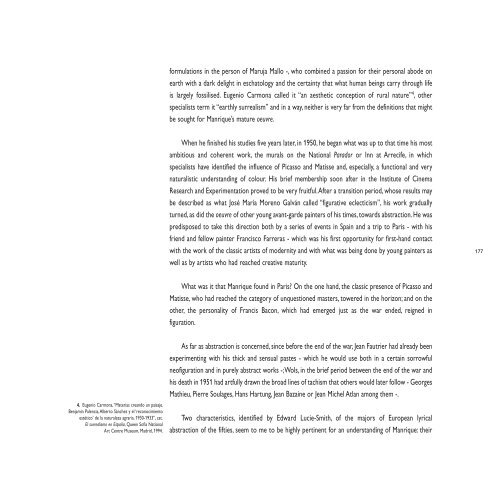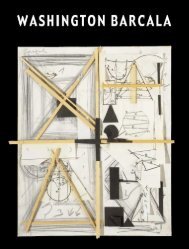VERSIÓN INGLESA ENGLISH VERSION - Fundación César Manrique
VERSIÓN INGLESA ENGLISH VERSION - Fundación César Manrique
VERSIÓN INGLESA ENGLISH VERSION - Fundación César Manrique
Create successful ePaper yourself
Turn your PDF publications into a flip-book with our unique Google optimized e-Paper software.
4. Eugenio Carmona, “Materias creando un paisaje.<br />
Benjamín Palencia, Alberto Sánchez y el ‘reconocimiento<br />
estético’ de la naturaleza agraria. 1930-1933”, cat.<br />
El surrealismo en España, Queen Sofia National<br />
Art Centre Museum, Madrid, 1994.<br />
formulations in the person of Maruja Mallo -, who combined a passion for their personal abode on<br />
earth with a dark delight in eschatology and the certainty that what human beings carry through life<br />
is largely fossilised. Eugenio Carmona called it “an aesthetic conception of rural nature” 4 , other<br />
specialists term it “earthly surrealism” and in a way, neither is very far from the definitions that might<br />
be sought for <strong>Manrique</strong>’s mature oeuvre.<br />
When he finished his studies five years later, in 1950, he began what was up to that time his most<br />
ambitious and coherent work, the murals on the National Parador or Inn at Arrecife, in which<br />
specialists have identified the influence of Picasso and Matisse and, especially, a functional and very<br />
naturalistic understanding of colour. His brief membership soon after in the Institute of Cinema<br />
Research and Experimentation proved to be very fruitful. After a transition period, whose results may<br />
be described as what José María Moreno Galván called “figurative eclecticism”, his work gradually<br />
turned, as did the oeuvre of other young avant-garde painters of his times, towards abstraction. He was<br />
predisposed to take this direction both by a series of events in Spain and a trip to Paris - with his<br />
friend and fellow painter Francisco Farreras - which was his first opportunity for first-hand contact<br />
with the work of the classic artists of modernity and with what was being done by young painters as<br />
well as by artists who had reached creative maturity.<br />
What was it that <strong>Manrique</strong> found in Paris? On the one hand, the classic presence of Picasso and<br />
Matisse, who had reached the category of unquestioned masters, towered in the horizon; and on the<br />
other, the personality of Francis Bacon, which had emerged just as the war ended, reigned in<br />
figuration.<br />
As far as abstraction is concerned, since before the end of the war, Jean Fautrier had already been<br />
experimenting with his thick and sensual pastes - which he would use both in a certain sorrowful<br />
neofiguration and in purely abstract works -; Wols, in the brief period between the end of the war and<br />
his death in 1951 had artfully drawn the broad lines of tachism that others would later follow - Georges<br />
Mathieu, Pierre Soulages, Hans Hartung, Jean Bazaine or Jean Michel Atlan among them -.<br />
Two characteristics, identified by Edward Lucie-Smith, of the majors of European lyrical<br />
abstraction of the fifties, seem to me to be highly pertinent for an understanding of <strong>Manrique</strong>: their<br />
177
















![Becas y premios de la Fundación César Manrique [1997-2006]](https://img.yumpu.com/20766851/1/184x260/becas-y-premios-de-la-fundacion-cesar-manrique-1997-2006.jpg?quality=85)
